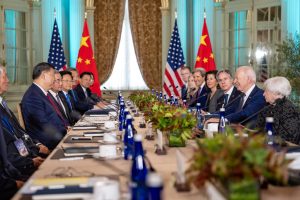Earlier this week, U.S. President Biden and Chinese President Xi Jinping held their first phone call since the two leaders met face-to-face in San Francisco last November. In the Chinese readout of the call, Xi reportedly stated that “China-U.S. relations are stabilizing.” Both sides have accepted the premise that bilateral competition requires diplomatic communication. Nonetheless, beneath the veneer of stability, the bilateral relationship is arguably more precarious than at any point since the Biden administration entered office.
The list of underlying tensions and risks across the relationship continues to grow. Although many frictions have persisted for an extended period, most have only worsened in recent years. The expanding size and scope of irritants renders diplomacy more important, but also more fragile.
Washington remains concerned about exit bans on U.S. citizens; cyberattacks on critical infrastructure; coercion toward Taiwan, the Philippines, and other U.S. partners; the strengthening of China-Russia economic ties; the erosion of Hong Kong’s autonomy; overcapacity in China’s industrial sector; and Beijing’s xinchuang strategy to replace American technology. The list goes on.
On the Chinese side, there remain concerns over perceived American interference in China’s domestic politics; support for Taiwan; efforts to build a “latticework” of American allies in the Indo-Pacific; Washington’s “small yard, high fence” approach to technology; and proliferating restrictions on Chinese firms, including the U.S. Congress’ recent effort to force a divestiture of TikTok.
Of course, the U.S.-China relationship has struggled with similar frictions for years. More recently, the relationship withstood several major shocks. U.S. House Speaker Nancy Pelosi’s visit to Taiwan in August 2022 and the balloon incident in February 2023 had the potential to result in significant escalation.
The difference now, however, is that no single flashpoint is undermining the relationship. Rather, relations suffer from a host of negative trends that are only worsening. Like a slow-moving train wreck, the growing array of irritants could push bilateral relations off the cliff. Even barring a near-term crisis, underlying tensions could overwhelm any prospect of durable stabilization.
Take the case of TikTok. The recent spat reveals the degree to which the United States and China are willing to bear high costs to promote national security and save face, respectively.
If China refuses to allow a forced divestiture of TikTok, as Chinese officials claim, the United States will face the loss of one of its most popular social media platforms. It will forgo small business revenues of more than $15 billion per year and cause financial losses for over 7,000 Americans who own shares in TikTok’s parent company, ByteDance. The national security risks of data leakage and misinformation on TikTok are high, but so are the potential costs of Congress’ proposed divestiture bill.
Likewise, on the Chinese side, the refusal to allow a divestiture could cost ByteDance $16 billion in annual revenue, or about 15 percent of the firm’s total sales. Depending on how TikTok is valued, ByteDance could face a market capitalization impairment of between $40 billion and $150 billion.
The TikTok issue is a symptom of larger friction in the U.S.-China relationship: both countries are willing to bear the costs of decoupling, even as they remain diplomatically engaged. If a company as large and as significant as TikTok can close its U.S. operations, many other, less significant companies are vulnerable to more restrictions in China and the United States going forward.
That said, the picture is not entirely bleak. Washington and Beijing have been able to reach consensus on some issues of importance to both countries. According to U.S. officials, China has implemented “initial measures to restrict and disrupt the flow of certain precursor chemicals used to produce illicit synthetic drugs.” Since Biden and Xi met in San Francisco, U.S. defense officials also state that the Chinese military has refrained from conducting dangerous intercepts of U.S. military assets.
Washington has responded with its own version of restraint. Following the election of Lai Ching-te in Taiwan, Biden gave a terse response to reporters, indicating his wariness of stepping over Beijing’s “red line.” In contrast to Biden’s previous statements that Washington would “defend Taiwan” if attacked, after the election, Biden only stated, “We do not support Taiwan independence.” Moreover, in contrast to prior interactions, the U.S. readout of Biden’s recent call with Xi neglected to mention whether the president raised concerns over the human rights situations in Xinjiang, Tibet, and Hong Kong.
Mutual accommodation on the margins has been driven by Beijing and Washington’s short-term incentives to moderate tensions. While China wants to focus on economic growth at home, the United States is grappling with a series of global crises, from Ukraine to the Middle East. Exogenous factors, however, are unlikely to serve as a durable basis for bilateral stabilization.
In the coming weeks and months, follow-up meetings between U.S. and Chinese officials will reinforce the premise that competition requires communication. But unless the two sides take genuine efforts to reduce the scope of underlying frictions, any stabilization will likely prove short-lived.

































